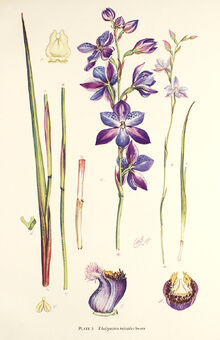| Thelymitra | ||||||||||||||||
|---|---|---|---|---|---|---|---|---|---|---|---|---|---|---|---|---|
| ||||||||||||||||
Thelymitra abbreviated as Thel in horticultural trade, is a genus of about 80 species of terrestrial tuberous plants in the Orchidaceae family
Distribution[]
They are about 100 species distributed in higher rainfall areas across Australia (with 50 or so species), New Zealand (10+ endemic species), New Caledonia (2), Timor, Java, and the Philippines.
Description[]
These terrestrial orchids are only above ground during spring and early summer, usually with a single leaf, growing up from two underground tubers. It is elongated or linear-lanceolate and glabrous. The Custard Orchid (T. villosa) is the only species with a hairy leaf. The leaves of T. spiralis and T. variegata are spirally twisted.
The flower stalk is usually a bluish-green colour. The flower stem usually carries 4 to 10 flowers (even up to 20 flowers in the Plain Sun Orchid, T. holmesii), often opening all at once, though some species have only one flower each year. The flower size is between 1 and 6 cm. These flowers only open in bright sunlight (in combination with warmth and humidity), close at night and during cold or cloudy weather.
Sun orchids exhibit a particular characteristic : their lip shows, except in a few species such as T. variegata, almost the same shape, colour, colour pattern or size as the other petals and sepals. This gives a symmetrical shape to the perianth. Furthermore the lip lacks ornamentation. In other orchid genera, the lip has a distinctive shape and colour. The particular shape and color of the sun orchids mimics the flowers of lily family (Liliaceae) and the family Goodeniaceae, aiming by deceit for the same insect pollinators. The Slender Sun Orchid (T.pauciflora) only opens for a short time (or not at all) and is self-pollinating. This self-pollination is a successful strategy followed by several other species such as and T. circumsepta, T. graminea, T. holmesii and T. mucida.
Once the weather dries out the leaf shrivels away and the orchid lies as a single spherical tuber.
Sun orchids come in most colours, including purple, deep blue (T. pauciflora), white, pink, magenta, maroon, yellow (T. antennifera) and red (T. x macmillanii). Most are a single colour or have spots, a few have stronger variation and are multi-coloured. The deep blue colour, found in about 75% of the sun orchids, is of a rare kind, found only in 5 other orchid genera.
Taxonomy[]
Several species are considered by the IUCN as endangered (T. epipactoides) or critically endangered (T. gregaria, T. hiemalis and T. x mackibbinii. A number of conservation measures are underway in South Australia.
Until shortly, the taxonomy of the genus was outmoded and understudied. Jeffrey A Jeanes of the Royal Botanic Gardens Melbourne has recently (2004) done a taxonomic revision, resolved several species complexes and described a considerable number of new species (see Muelleria 19; 2004)
Culture[]
Grow in cool to intermediate conditions. Plants emerge in late summer and flowers during the winter. They should be grown in full sun. Due to the flowers only opening in warm weather, it is common practice for showing them, to use a bank of strong incandescent lights to simulate the warm sun.
Water regularly during growing season and reduce with hold watering during dormancy. Seeds can be sprayed lightly during dormancy to prevent dehydration.
Thelymitras can be grown in a freely draining, dense mixture with partially composted organic matter. A suitable mixture is an equal mix of 7 mm road screenings, year old composted wood chips and commercial potting mix. Plants can be potted in 80% perlite and 20% leaf litter. It is good practice to cover the surface in pine or she-oak needles to control water loss and to feed the mychorizal fungi that support the orchid. The pH of the media should be 5 to 6.
Naming[]
The type species is Thelymitra longifolia J.& G. Forst. 1775 from the South Island of New Zealand. The scientific name Thelymitra was given by J. R. and G. Forster, botanists on Captain Cook's second voyage. The genus name is derived from the Greek words thely (woman) and mitra (mitre hat), referring to elaborate shape of the staminodal (staminode = sterile stamen) structure at the top of the column, called a mitra.
Synonyms[]
- Macdonaldia Gunn ex Lindl. 1840
Species[]
|
Natural Hybrids[]
- Thelymitra × chasmogama R.S.Rogers 1927 (T. luteocilium × T. nuda)
- Thelymitra × dentata L.B.Moore, 1968. (T. longifolia × T. pulchella)
- Thelymitra × mackibbinii F.Muell. 1881 (T. × macmillanii × T. nuda)
- Thelymitra × macmillanii F.Muell. 1865 (T. antennifera × T. luteocilium)
- Thelymitra × truncata R.S.Rogers 1917
